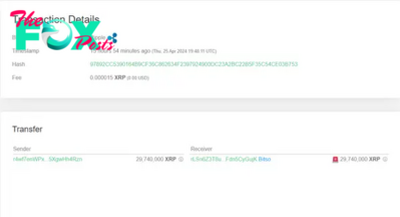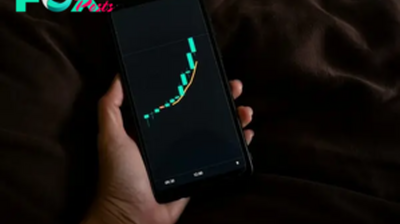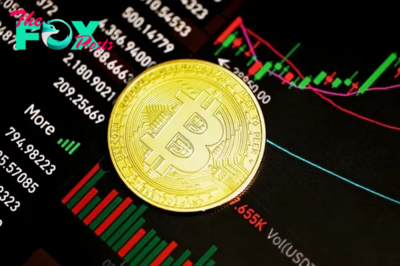Cryptocurrency
All 21 Million Bitcoin Already Exist Waiting To Be Unlocked By Auction

Most people who understand bitcoin know that there are two kinds of bitcoin. One is bitcoin, the asset which has a fixed supply and is quite volatile, and the second kind of Bitcoin, the network and protocol that maintains an immutable ledger that has never been hacked and is bullet proof, bomb proof and tank proof. It is my opinion that too much focus is placed on the asset and not nearly enough on the network, protocol and immutable ledger.
While listening to a recent podcast Peter McCormack had with Dhruv Bansal they discussed the network and protocol in a new way.
I really liked Dhruv’s framing of how to view the fixed supply of bitcoin. The two versions can be simplified as follows:
Version 1: The Commonly Held View
The 21 million will be issued across a 131 year period from 2009 until 2140. Not all bitcoin have been issued or created yet. This view holds that as of March 2024 there have been roughly 19,659,000 bitcoin issued or created which is 93.62% of the entire supply. In the current epoch, the way you’d describe this is “6.25 bitcoin are created roughly every ten minutes.”
Version 2: Dhruv’s View
ALL 21 million were created via the network, consensus mechanisms, algorithms and protocol on January 3, 2009 and as of that date its monetary policy and hence the supply issuance for those 21 million was fixed on that date. ALL 21,000,000 ALREADY EXIST BUT HAVE NOT YET BEEN RELEASED OR UNLOCKED. Dhruv used the term “released” to signify how many bitcoin are issued every ten minutes. I will use the term “unlocked” for the balance of this article to further amplify the brilliance of Dhruv’s framing. Bitcoiners are already familiar with time locked bitcoin and in a sense Dhruv’s framing just extends the idea of time locked bitcoin to its logical conclusion. The time lock schedule for Epoch 1 ran for 210,000 blocks. The next time lock schedule for Epoch 2 ran for 210,000 blocks and so forth.
Why is Dhruv’s framing important?
By framing mining as buying coins rather than creating coins it helps us make sense of the constantly increasing difficulty. How do we protect this fixed supply of 21 million coins and prevent human cheating for 131 years?
If miners are creating bitcoins, then it appears that they are using ever more resources to create ever fewer coins over time. This makes bitcoin seem like it suffers an “inefficiency of scale” — as bitcoin adoption grows, more resources are used in mining, and the cost of bitcoin production *increases* instead of decreasing, as we would expect in any other industry. This is part of the reason (Dhruv suspects) why many people prima facie object to bitcoin mining — it just seems dumb and wasteful that it works this way!
Conversely, if we think of bitcoin miners as *purchasing* bitcoins from an existing supply [paid for in computations] then the increasing resources used by miners makes sense — as bitcoin adoption grows, bitcoins become more valuable, the security of the network increases and the network adjusts the price of newly released bitcoins upward. Dhruv thinks this framing could help to alleviate some people’s negative first impressions of the mining market.
Note: The reason this framing makes sense is Satoshi created an entirely new way to tell time with distributed systems. I don’t think we give him/her/them nearly enough credit for this! As Gigi points out in Bitcoin Is Time, in the absence of a central authority Satoshi had to invent a new way for a group of decentralized computers to tell time. Satoshi chose ten minutes as the target block time and enforced it via an auction. Humans are deeply tied to time as we understood it before bitcoin so some of us will have a hard time seeing it as Dhruv suggests.
The Bitcoin Base Layer Has Two Markets
Dhruv posits there are two markets operating in Bitcoin AT ALL TIMES that make up the base layer of Bitcoin. Layer zero and Layer one.
Layer zero is what I’d call the security layer and the monetary policy layer and it is enabled via math and code at an auction that occurs every block which takes on average 10 minutes. Every block since January 3, 2009 the Bitcoin network has held an auction that has a fixed asking price [measured in computations] that is selling the next tranche of bitcoin that already exist to the entire global bitcoin mining industry. An example of massive collaboration if ever there was one! Back when it was just Satoshi and Hal Finney there wasn’t a global bitcoin mining industry, but you get the gist.
Today I think the global bitcoin mining industry is better and more accurately thought of as the Bitcoin network security layer, but that is a topic for another article. Dhruv points out that this is a “two sided auction where you get this many coins for this many computations.” The entire industry of bitcoin miners [timestamp servers] paid the computational price collectively for that block. There are this many coins [depending on the epoch] for this many computations and the network waits to unlock the next batch of coins until one fortunate miner comes in that meets that minimum computational price.
There is a persistent guessing Game using proof of work that goes on among all the time stamp servers who are plugged into the Bitcoin network. This is what gives the Bitcoin network such amazing security. Eventually one of these timestamp servers “wins the auction” using Dhruv’s framing and earns the block reward. Every time stamp server for that 10 minute period is serving the purpose of making the network extremely secure but only one time stamp server wins the block reward. Technically this one time stamp server is often operating in a mining pool but that does not matter for purposes of this article. If the network paid too many computations or too few then the TIME IT TOOK TO MEET THAT BID WAS DIFFERENT THAN 10 MINUTES.
The network protocol and software tracks these 2016 auctions during this 2016 block span and makes note of the times for each block. He says, “Each of those times can be thought of itself as a bid. The entire industry is offering these bids in sequence and the network pauses and says ‘what were the most recent bids in time?’ and readjusts the price it pays the miners (the security force) so that the bidding time matches the target time.”
The big idea is Bitcoin Layer zero is a market between the entire network of users and the entire network of bitcoin miners which forms the security layer for the network. This market acts as an energetic force field protecting the network every moment of every day since 2009. Why call it a market? Dhruv believes that all decentralized systems must be markets in order to work. [In this case Layer zero is a collective market that involves computations for the timed release or unlock of bitcoin. And, additionally this collective market provides security services for the timechain.]
What Is The Core Trade On Layer Zero?
What is the core trade on Layer zero? Bansal says “it’s computations for bitcoin.” Layer 0 is a “market between two aggregates.” It’s a market between the entire bitcoin network [who want security] and the entire bitcoin mining industry who want security and the block reward. There are only two “participants” in this layer. This market is closely related to another market [Layer 1] which is the market for block space. Bob Burnett has also been saying this in a different way by pointing out there are two kinds of scarcity in bitcoin. We can call Layer one the final settlement and transaction layer of Bitcoin.
Layer zero solves the problem of how to release or unlock a fixed supply of currency fairly into circulation and secure the network until the year 2140 using proof of work.
The Layer 1 market is how do I get transactions to achieve finality and change ownership on an immutable ledger? Each market has an artificial and purposeful constraint. Layer 0 is the fixed number of coins released or unlocked over 131 years. Layer 1 is the blocksize or block space. Layer 1 is a market between individuals. How much is the individual user willing to pay to include this transaction in a block?
Occasionally there are blocks mined that have zero transactions in them. For those who think “how wasteful,” think again. These blocks prove the value and existence of the security layer. Any blocks mined with zero transactions in it proves there is a Layer zero market and it ignores the Layer 1 market. [It also reinforces Dhruv’s point that there are two markets.] Over time as all bitcoin are released into circulation, the Layer zero market goes away. It is no longer needed. At that point, the only market remaining for the base layer will be Layer 1. Most bitcoiners believe the transaction fees alone will be sufficient to continue to secure the Bitcoin network long into the future. Conceptually the Layer one market will take over and secure the immutable ledger to be sure no one cheats.
There are some who believe that transaction costs won’t provide enough incentive for miners to continue to mine, but there are two markets, and the first market Layer Zero is a long way from done.
The incentives to mine are already very strong [there are something like 20 publicly traded companies] and these incentives are getting stronger every day. I know of many bitcoiners who currently run their miners for the heat it delivers and so they have a strong incentive to continue even after the Layer zero market has served its purpose. There are entrepreneurs looking to build Businesses around these timestamp servers that will heat pools, heat hot water, heat rooms, heat homes and heat buildings and will provide electricity to people in the world who have none. In fact, I predict in the next few years there will be appliances built for the heat they produce.
In addition, miners are in a constant world-wide search for places where there is free energy, stranded energy, wasted energy, methane mitigation and even waste tires they can use as a fuel source. There are also nation states that are mining bitcoin. Anyone with a significant amount of bitcoin will have plenty of incentive to keep mining so long as the value of the network continues to grow AND nation states keep devaluing their currency to zero. In addition, there is a new form of energy technology called OTEC that I suspect will become a breakthrough form of energy that will be proven workable near the equator because of bitcoin mining.
Bitcoin is a layer of markets. These first two markets run separately from each other. And there is a Layer 2 that has emerged and is still being built that delivers fast settlement and payments. Layer zero is the security layer and supply unlock layer. Layer 1 is the store of value layer and final settlement layer. Layer 2 is medium of exchange and fast settlement layer.
For those who find these ideas foreign or hard to grasp feel free to ignore them or tell us where our gaps in thinking occur. Take solace in the idea that free markets and math secure your bitcoin [instead of central bankers] and will do so into the foreseeable future.
Special thanks to Dhruv Bansal for providing constructive input on this article.
This is a guest post by Mark Maraia. Opinions expressed are entirely their own and do not necessarily reflect those of BTC Inc or Bitcoin Magazine.
#crypto
-

 Cryptocurrency23h ago
Cryptocurrency23h agoHere’s Where They Are Sending Coins
-

 Cryptocurrency23h ago
Cryptocurrency23h agoShadow Boxing
-

 Cryptocurrency1d ago
Cryptocurrency1d agoTop 10 Tips for Every Bitcoin Multisig Beginner
-

 Cryptocurrency1d ago
Cryptocurrency1d agoEthereum Withdrawals From Exchanges Top 260,000 ETH
-

 Cryptocurrency1d ago
Cryptocurrency1d agoAnalysts Call It: XRP Primed For A 700% Surge
-

 Cryptocurrency1d ago
Cryptocurrency1d agoWiener AI Launches ICO & Raises Over $350K
-

 Cryptocurrency1d ago
Cryptocurrency1d agoCrypto Bull Run Set To Return Next Week, Predicts Arthur Hayes
-

 Cryptocurrency1d ago
Cryptocurrency1d agoShiba Inu Devs Schedule Shibarium Hard Fork: Details




























